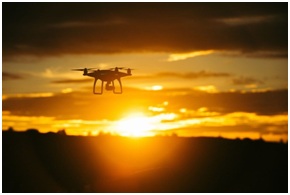Researchers have developed a real-time approach that can help prevent incidents like the large-scale disruption at London’s Gatwick Airport in 2018, where possible drone sightings at the perimeter of the airport caused the cancellation of hundreds of flights.
The researchers, from the University of Cambridge in the U.K., used a combination of statistical techniques and radar data to predict the flight path of a drone, and whether it intends to enter a restricted airspace, for instance around a civilian airport.
Their solution could help prevent a repeat of the Gatwick incident, as it can spot any drones before they enter restricted airspace and can determine, early, if their future actions are likely to pose a threat to other aircraft.
This new predictive capability can enable automated decision-making and significantly reduce the workload on drone surveillance system operators by offering actionable information on potential threats to facilitate timely and proportionate responses.
Real radar data from live drone trials at several locations was used to validate the new approach. Some of the results were reported at the Sensor Signal Processing for Defence Conference in Edinburgh, Scotland on September 15.
Drones have become ubiquitous over the past several years, with widespread applications in agriculture, surveying and e-commerce, among other fields. However, they can also be a nuisance or present a potential safety risk, especially with the wide availability of cheap and increasingly more capable platforms.
A few days before Christmas 2018, reported drone sightings near the perimeter of Gatwick Airport caused hundreds of flights to be disrupted due to the possible risk of collision. No culprit was found.
“While we don’t fully know what happened at Gatwick, the incident highlighted the potential risk drones can pose to the public if they are misused, whether that’s done maliciously or completely innocently,” said paper co-author Dr Bashar Ahmad, who carried out the research while based at Cambridge’s Department of Engineering. “It’s crucial for future drone surveillance systems to have predictive capabilities for revealing, as early as possible, a drone with malicious intent or anomalous behavior.”
To aid with air traffic control and prevent any possible collisions, commercial airplanes report their location every few minutes. However, there is no such requirement for drones.
“There needs to be some sort of automated equivalent to air traffic control for drones,” said Professor Simon Godsill from Cambridge’s Department of Engineering, who led the project. “But unlike large and fast-moving targets, like a passenger jet, drones are small, agile, and slow-moving, which makes them difficult to track. They can also easily be mistaken for birds, and vice versa.”








